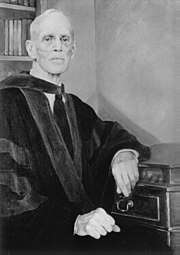James Alan Montgomery
James Alan Montgomery (June 13, 1866 – February 6, 1949) was an American Episcopal clergyman, Oriental scholar, and biblical scholar who was professor of Old Testament and Semitics (Hebrew and Aramaic), first at the Philadelphia Divinity School, and later, from 1913 to 1948, at the University of Pennsylvania. He served as president of the American Oriental Society and Society of Biblical Literature and Exegesis.[1][2]

Circa 1930 portrait
Montgomery was born in Germantown, Philadelphia, the eldest son of Thomas Harrison Montgomery, a businessman, and Anna Morton Montgomery. He graduated from the University of Pennsylvania in 1887, and the Philadelphia Divinity School in 1890.[1]
Books
- Commentaries on the books of Kings and Daniel
- A Critical and Exegetical Commentary on the Books of Kings
- The Samaritans: The Earliest Jewish Sect; Their History, Theology and Literature, J.C. Winston Company (1907)
- Aramaic Incantation Texts from Nippur, University Museum (1913)
- The Origin of the Gospel according to St. John, John C. Winston Co. (1923)
- History of Yaballaha III, Nestorian Patriarch and of His Vicar Bar Sauma, Mongol Ambassador to the Frankish Courts at the End of the Thirteenth Century, Columbia University Press (1927)
- Arabia and the Bible, University of Pennsylvania Press (1934)
- The Ras Shamra Mythological Texts, with Zellig S. Harris (1935)
- The Holy City and Gehenna
gollark: Getting the locale sounds like SIDE EFFECTS!
gollark: Rust.
gollark: Do notation is just a nice way to write `>>=`s and lambdas.
gollark: A useful combinator:```haskells :: t1 -> (((t2 -> t2 -> t3 -> t4) -> t2 -> (t2 -> (t2 -> t2 -> t3 -> t4) -> t3) -> t4) -> t1 -> (IO a -> a) -> t5) -> t5s x k = k z x unsafePerformIO```
gollark: servant-generic:```This package has been merged into servant 0.14.1, please use that instead if available.```
References
- Speiser, E. A. (1949). "James Alan Montgomery (1866–1949)". Bulletin of the American Schools of Oriental Research (115): 4–8. JSTOR 3218791.
- Hallote, Rachel (2011). "Before Albright: Charles Torrey, James Montgomery, and American Biblical Archaeology 1907–1922". Near Eastern Archaeology. 74 (3): 156–169. doi:10.5615/neareastarch.74.3.0156.
This article is issued from Wikipedia. The text is licensed under Creative Commons - Attribution - Sharealike. Additional terms may apply for the media files.